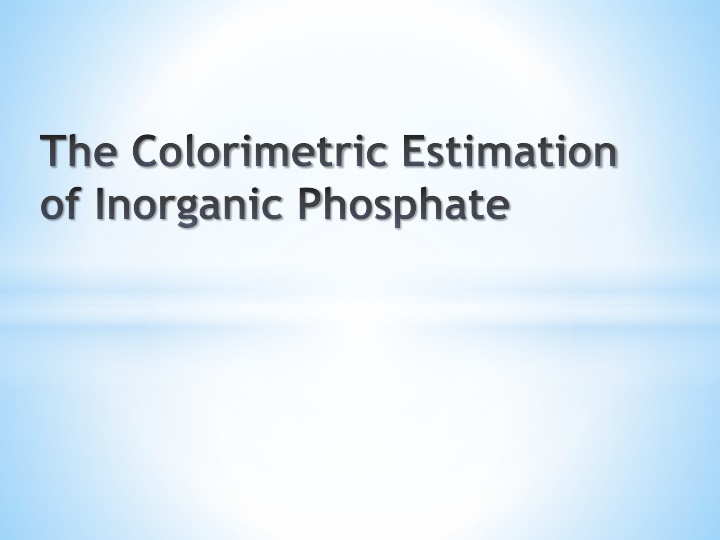
Colorimetric Estimation of Inorganic Phosphate in Biochemistry Lab
Explore the colorimetric estimation of inorganic phosphate, a common determination in biochemistry labs. Learn about the principles, reactions, and method involving ammonium molybdate and phosphomolybdic acid. Follow a standard curve for accurate results.
Download Presentation

Please find below an Image/Link to download the presentation.
The content on the website is provided AS IS for your information and personal use only. It may not be sold, licensed, or shared on other websites without obtaining consent from the author. If you encounter any issues during the download, it is possible that the publisher has removed the file from their server.
You are allowed to download the files provided on this website for personal or commercial use, subject to the condition that they are used lawfully. All files are the property of their respective owners.
The content on the website is provided AS IS for your information and personal use only. It may not be sold, licensed, or shared on other websites without obtaining consent from the author.
E N D
Presentation Transcript
The Colorimetric Estimation of Inorganic Phosphate
File:Phosphat-Ion.svg Introduction A phosphate, an inorganic chemical, is a salt of phosphoric acid It consists of one central phosphorus atom surrounded by four oxygen atoms in a tetrahedral arrangement. The phosphate ion carries a negative three formal charge
phosphorus is found as a free phosphate ion in solution and is called inorganic phosphate, to distinguish it from phosphates bound in various phosphate esters. Inorganic phosphate is generally denoted Pi
Phosphate are most commonly found in the form of adenosine phosphates, (AMP, ADP and ATP) and in DNA and RNA
Principle The measurement of inorganic phosphate must be one of the comments determinations carried out in a biochemistry lab. It is certainly surprising how frequently such a measurement is required, and the production of a standard curve is a useful exercise for checking the validity of Beer s Law.
Inorganic phosphate reacts with ammonium molybdate in an acid solution to form phosphomolybdic acid. A reducing agent such as metol is added which reduces the molybdenum to give a blue colour but does not affect the uncombined molybdic acid.
Acid solu Pi + ammonium molybdate phosphomolybdic acid phosphomolybdic acid + metol(reducing agent) blue colour Metol not combine with excess of molybdic acid
Blank Std1 1ml Std2 0.7ml 0.3ml 3ml Std3 Std4 Std5 0.5ml 0.3ml 0.5ml 0.7ml 1ml 3ml 3ml un _ _ 3ml TCA St.sol(w.s) _ Copper acetate buffer(pH4) Ammonium molybdate 0.9ml 0.1ml 3ml _ 3ml 3ml 0.5ml 0.5ml 0.5ml 0.5ml 0.5ml 0.5ml 0.5ml Metol Unknown 0.5ml _ 0.5ml _ 0.5ml _ 0.5ml 0.5ml 0.5ml _ _ 0.5ml 1ml _ Mix, incubate at RT for 10 min. And then read at 880nm.
Calculation C1 X V1 = C2 X V2
Introduction Inorganic phosphate react with ammonium molybdate in an acid solution to form phosphomolybdic acid. A reducing agent such as metol is added which reduces the molybdenum to give a blue colour but does not affect the uncombined.
